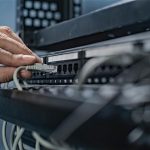In the age of information and digital connectivity, the internet has become the backbone of our daily activities. Whether you’re working remotely, streaming hi- def movies, attending virtual meetings, or simply scrolling through social media, the quality of your experience is often influenced by a critical factor: internet speed.
Internet speed can be a confusing topic, with terms like “megabits per second (Mbps),” “bandwidth,” “latency,” and “upload vs/ download speed” being thrown around. At ADC Technologies, we want you to understand the concept of internet speed by explaining what it is, how it’s measured, and why it matters for different activities.
What is Internet Speed?
At its core, internet speed refers to the rate at which data is transferred from the web to your device (or vice versa) over a connection. It measures how quickly you can download or upload information on the internet. Internet speed is typically measured in megabits per second (Mbps), though for very fast connections, it can also be measured in gigabits per second (Gbps).
1 Mbps = 1 million bits of data transferred per second
1 Gbps = 1,000 Mbps (or 1 billion bits per second)
The higher the number of Mbps, the faster the internet connection. However, faster doesn’t always mean better, depending on your needs and the types of tasks you’re performing online.
Components of Internet Speed
Internet speed consists of two primary components:
Download Speed: This is the rate at which data is transferred from the internet to your device. It affects activities like streaming videos, loading web pages, downloading files, and receiving emails. Download speed is the most commonly advertised aspect of internet speed by Internet Service Providers (ISPs) because it’s crucial for many online activities.
Upload Speed: This is the rate at which data is transferred from your device to the internet. Upload speed is essential for tasks like uploading large files to cloud storage, sending emails with attachments, hosting video calls, or live streaming.
Typically, download speeds are much higher than upload speeds in most home internet plans because most online activities are more download-heavy.
How is Internet Speed Measured?
Internet speed is measured in Mbps, and it’s an indication of how much data can be transferred within one second. Let’s break down the meaning of these measurements:
Bandwidth: Often confused with internet speed, bandwidth refers to the capacity of your connection. Imagine bandwidth as the width of a highway- more lanes mean more cars can travel simultaneously, but it doesn’t necessarily mean they’ll move faster. The higher your bandwidth, the more data can be transferred at once, allowing more simultaneous users or devices to use the connection without noticeable slowdowns.
Latency: While speed is important, latency (also called “ping”) plays a significant role in the perceived quality of your internet connection. Latency refers to the time it takes for data to travel from your device to the server and back. It’s measured in milliseconds (ms). A high latency means more delay, which can make real-time communication, gaming, and video conferencing more difficult. Lower latency is better, especially for interactive applications.

Factors That Affect Internet Speed
Your internet speed is influenced by several factors, including:
Type of Internet Connection: The type of technology that connects your home or business to the internet has the most significant impact on speed.
- Fiber-Optic: Fiber-optic connections are the fastest currently available. They use light signals transmitted through glass fibers, offering blazing-fast download and upload speeds—often 1 Gbps or higher. Fiber is also less prone to interference, making it a stable option for high-speed internet.
- Cable: Cable internet uses the same coaxial cables that deliver TV service. Cable connections are widely available and generally offer fast download speeds (typically ranging from 25 Mbps to 1 Gbps), but upload speeds are often slower. Cable networks are shared among users in the same area, so speeds can drop during peak usage times.
- DSL (Digital Subscriber Line): DSL uses existing telephone lines to provide internet service. While it’s slower than cable and fiber (with typical speeds ranging from 1 Mbps to 100 Mbps), DSL is still a common option in rural areas where cable or fiber may not be available.
- Satellite: Satellite internet is usually available in remote areas where other options are limited. However, it tends to have slower speeds (around 12-100 Mbps) and high latency, making it less ideal for activities that require real-time interaction, such as gaming or video calls.
5G/4G LTE: Wireless mobile internet can be fast, especially with 5G technology, offering speeds up to 1 Gbps in some areas. However, this speed depends on network congestion, signal strength, and proximity to cell towers.
Network Congestion: Internet speeds can slow down when many people in the same area are using the network simultaneously. This is common during peak times—typically in the evening when people are streaming videos, playing online games, or video conferencing. Shared connections (like cable internet) are more susceptible to congestion than dedicated connections (like fiber).
Wi-Fi vs. Wired Connections: Your Wi-Fi setup plays a crucial role in the internet speed you experience. While wired connections via Ethernet cables offer faster and more stable speeds, Wi-Fi signals can be disrupted by obstacles like walls or other electronic devices. The further you are from your Wi-Fi router, the weaker the signal, which can result in slower speeds.
Device Limitations: The speed of your device’s processor, memory, and Wi-Fi capabilities can also affect the speed you experience. For instance, an older smartphone or computer may not be able to take full advantage of high-speed internet, even if your ISP provides it.
ISP Throttling: Some ISPs throttle (limit) your speed after you’ve reached a certain amount of data usage, particularly in unlimited plans where speeds slow down after you’ve used a certain amount of data in a billing cycle. This is more common in mobile data plans but can also occur with home broadband plans.
Software and Applications: Certain applications, particularly those that download or upload large files in the background, can slow down your overall internet speed. Malware or outdated software can also degrade performance.
How Much Internet Speed Do You Need?
The amount of speed you need depends on your internet usage. Here are some guidelines for different online activities:
- Web Browsing and Email: Basic web browsing, checking email, and light social media use don’t require a lot of speed. Typically, 1-5 Mbps is more than sufficient for these tasks.
- Streaming Video: Video streaming is more bandwidth-intensive, especially for higher resolutions:
- Standard Definition (SD): 3-5 Mbps
- High Definition (HD): 5-10 Mbps
- 4K/Ultra HD: 25 Mbps or more
- Online Gaming: Gaming doesn’t require as much bandwidth as video streaming, but low latency is critical for a smooth experience. Most games require 3-6 Mbps, but lower latency (under 50ms) is far more important for responsiveness.
- Video Conferencing: Video calls, particularly in high definition, require both good download and upload speeds. For platforms like Zoom or Skype, you’ll need at least 3-6 Mbps for smooth, uninterrupted communication. Group video calls or HD conferencing might require more speed.
- Remote Work and Cloud Computing: If you’re uploading or downloading large files, sharing documents in real-time, or using cloud-based applications, faster speeds (10-50 Mbps) and balanced upload/download rates are beneficial.
- Multiple Devices: If you have a household where multiple devices are being used simultaneously, you’ll need more bandwidth to accommodate them. For example, if someone is streaming a 4K movie while others are working or gaming, you’ll likely need a connection of 100 Mbps or more to avoid bottlenecks.
How to Test Your Internet Speed
Testing your internet speed is simple and can be done using free online tools like Speedtest.net or Fast.com. These tests measure your download speed, upload speed, and ping (latency). Here’s what the results typically indicate:
Download Speed: This is the number you’ll probably focus on the most, as it determines how quickly you can receive data. If this number is much lower than what your ISP advertises, there may be issues with your connection.
Upload Speed: Often lower than your download speed, this number is important for tasks like uploading files, video conferencing, or live streaming.
Ping (Latency): A high ping time (above 100 ms) can indicate delays in your connection, which is especially problematic for online gaming or video conferencing.
Improving Internet Speed
If you’re not getting the speeds you expect, there are several steps you can take to improve your connection:
- Check for Interference: Ensure your Wi-Fi router isn’t near other electronics or thick walls that might disrupt the signal.
- Upgrade Your Router: Older routers may not support the higher speeds of modern connections, especially if you’ve upgraded your internet plan.
- Use Wired Connections: Ethernet cables offer faster, more stable connections compared to Wi-Fi. Consider using them for stationary devices like desktops, gaming consoles, or smart TVs.
- Limit Bandwidth-Hogging Devices: If multiple devices are streaming or downloading large files simultaneously, your speed will slow down. Pause non-essential tasks or consider upgrading your plan if you need to support heavy usage.
- Contact Your ISP: If you’ve tried all of the above and your speed is still slow, it might be worth reaching out to your ISP to troubleshoot or inquire about faster plans. Reaching out to ADC Technologies is, of course, the most preferred method to trouble shooting.
Understanding internet speed and how it impacts your online activities is crucial in today’s digital world. Casual user’s who enjoy browsing the web and streaming videos, or a power user relying on high-speed connections for remote work, gaming, or content creation, your internet speed can make or break your experience.
The right speed for you depends on your specific needs, the number of devices connected, and the type of activities you engage in online. By knowing how internet speed works, what affects it, and how to test and improve it, you can ensure you’re getting the best possible performance from your connection.



